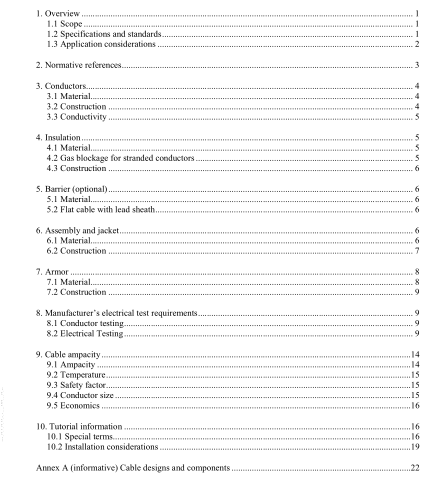IEEE 1018-2013 pdf download.IEEE Recommended Practice for Specifying Electric Submersible Pump Cable—Ethylene-Propylene Rubber Insulation
Cable purchased under the recommendation of this recommended practice, unless otherwise specified herein, should meet the requirements of ASTM B3, ASTM B8, ASTM B33, ASTM B 189, ASTM B496, and ANSI/NEMA WC 71/ICEA S-96-659, where applicable.
1 1.3 Application considerations
While operating temperature is the main factor in selecting the type of insulation to be used, there are many other factors that should be considered when choosing an appropriate electric submersible pump (ESP) cable design. Conductor size, insulation thickness, types of barriers or braids, jacket material, cable geometry, armor material, and thickness should all be chosen with respect to specific well and operational factors including but not limited to:
The economic impact of conductor size selection
Start-up current and maximum voltage drop to assure motor starting
Voltage rating to optimize cable and system run life
The projected heat rise due to voltage imbalance
Available space between the tubing and the casing
The amount and type of gas in the well
Corrosiveness of the well environment
The effect of any corrosion inhibitors or other chemical additives on insulation properties
The type of annulus fluid surrounding the cable when it is set above a packer
The rate and frequency of decompression cycles
The magnitude and frequency of temperature cycles
Crane pick weight capacity in offshore applications
Future uses for the cable beyond the well under consideration
Inclusion of chemical injection or communication lines in the cable
Wellbore trajectory
Clamping and banding methods
Because there are so many considerations involved in making the proper cable selection, it is very important for the operator to engage the assistance of its supplier’s cable application engineers during the cable selection process. Each manufacturer has extensive experience with all the features and benefits of their particular cable offerings, and its input can be invaluable in choosing the proper cable to maximize the value of cable investments. API 11S3 and API RP 11S5 contain information regarding the installation and application of submersible pump cable.
NOTE—While this recommended practice recognizes the common practice of continuing to operate the pump’s electrical system after a phase has faulted to ground and that some power distribution systems are even designed with one corner of the delta system grounded, it neither condones nor disapproves of such practice. However, the user should be aware that such operation produces a higher than normal phase-to-ground voltage across the insulation jacket dielectric of the two ungrounded conductors. Due to the disruption of the normally balanced three-phase field, such operation produces stresses through the insulation/jacket dielectric, which shortens cable life.
2. Normative references The following referenced documents are indispensable for the application of this document (i.e., they must be understood and used, so each referenced document is cited in text and its relationship to this document is explained). For dated references, only the edition cited applies. For undated references, the latest edition of the referenced document (including any amendments or corrigenda) applies.
ANSI/NEMA WC 71/ICEA S‐96‐659, Standard for Nonshielded Cables Rated 2001 – 5000 Volts for Use in the Distribution of Electric Energy.
API RP 11S3, Recommended Practice for Electric Submersible Pump Installations.
API RP 11S4, Recommended Practice for Sizing and Selection of Electric Submersible Pump Installation.
API RP 11S5, Recommended Practice for Application of Electric Submersible Cable Systems.
API RP 11S6, Recommended Practice for Testing of Electric Submersible Pump Cable Systems.
ASTM A90, Standard Test Method for Weight [Mass] of Coating on Iron and Steel Articles with Zinc or Zinc-Alloy Coatings.
ASTM B3, Standard Specification for Soft or Annealed Copper Wire.
ASTM B8, Standard Specification for Concentric-Lay-Stranded Copper Conductors, Hard, Medium-Hard,or Soft.
ASTM B33, Standard Specification for Tinned Soft or Annealed Copper Wire for Electrical Purposes.
ASTM B189, Standard Specification for Lead-Coated and Lead-Alloy-Coated Soft Copper Wire for Electrical Purposes.
ASTM B496, Standard Specification for Compact Round Concentric-Lay-Stranded Copper Conductors.IEEE 1018 pdf download.IEEE 1018-2013 pdf download
IEEE 1018-2013 pdf download

Leave a Reply